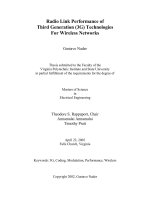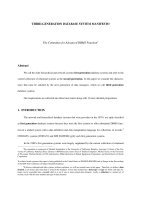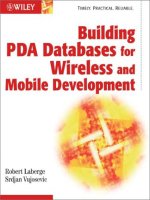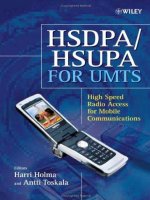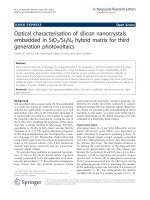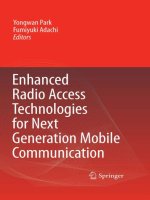wcdma for umts radio access for third generation mobile communications
Bạn đang xem bản rút gọn của tài liệu. Xem và tải ngay bản đầy đủ của tài liệu tại đây (9.27 MB, 481 trang )
WCDMA
FOR
UMTS
Radio Access for Third Generation
Mobile Communications
Third Edition
Edited by
Harri Holma and Antti Toskala
Both of
Nokia, Finland
WCDMA
FOR
UMTS
WCDMA
FOR
UMTS
Radio Access for Third Generation
Mobile Communications
Third Edition
Edited by
Harri Holma and Antti Toskala
Both of
Nokia, Finland
Copyright # 2004 John Wiley & Sons Ltd, The Atrium, Southern Gate, Chichester,
West Sussex PO19 8SQ, England
Telephone (+44) 1243 779777
Email (for orders and customer service enquiries):
Visit our Home Page on www.wileyeurope.com or www.wiley.com
All Rights Reserved. No part of this publication may be reproduced, stored in a retrieval system or transmitted
in any form or by any means, electronic, mechanical, photocopying, recording, scanning or otherwise, except
under the terms of the Copyright, Designs and Patents Act 1988 or under the terms of a licence issued by the
Copyright Licensing Agency Ltd, 90 Tottenham Court Road, London W1T 4LP, UK, without the permission
in writing of the Publisher. Requests to the Publisher should be addressed to the Permissions Department,
John Wiley & Sons Ltd, The Atrium, Southern Gate, Chichester, West Sussex PO19 8SQ, England, or
emailed to , or faxed to (+44) 1243 770620.
Designations used by companies to distinguish their products are often claimed as trademarks. All brand names
and product names used in this book are trade names, service marks, trademarks or registered trademarks
of their respective owners. The Publisher is not associated with any product or vendor mentioned in this book.
This publication is designed to provide accurate and authoritative information in regard to the subject matter
covered. It is sold on the understanding that the Publisher is not engaged in rendering professional services. If
professional advice or other expert assistance is required, the services of a competent professional should be
sought.
Other Wiley Editorial Offices
John Wiley & Sons Inc., 111 River Street, Hoboken, NJ 07030, USA
Jossey-Bass, 989 Market Street, San Francisco, CA 94103-1741, USA
Wiley-VCH Verlag GmbH, Boschstr. 12, D-69469 Weinheim, Germany
John Wiley & Sons Australia Ltd, 33 Park Road, Milton, Queensland 4064, Australia
John Wiley & Sons (Asia) Pte Ltd, 2 Clementi Loop #02-01, Jin Xing Distripark, Singapore 129809
John Wiley & Sons Canada Ltd, 22 Worcester Road, Etobicoke, Ontario, Canada M9W 1L1
Wiley also publishes its books in a variety of electronic formats. Some content that appears in
print may not be available in electronic books.
British Library Cataloguing in Publication Data
A catalogue record for this book is available from the British Library
ISBN 0-470-87096-6
Typeset in 10/12pt Times by Thomson Press (India) Limited, New Delhi.
Printed and bound in Great Britain by TJ International, Padstow, Cornwall.
This book is printed on acid-free paper responsibly manufactured from sustainable forestry
in which at least two trees are planted for each one used for paper production.
Contents
Preface xv
Acknowledgements xix
Abbreviations xxi
1 Introduction 1
Harri Holma, Antti Toskala and Ukko Lappalainen
1.1 WCDMA in Third Generation Systems 1
1.2 Air Interfaces and Spectrum Allocations for Third Generation Systems 2
1.3 Schedule for Third Generation Systems 5
1.4 Differences between WCDMA and Second Generation Air Interfaces 6
1.5 Core Networks and Services 9
References 10
2 UMTS Services and Applications 11
Harri Holma, Martin Kristensson, Jouni Salonen and Antti Toskala
2.1 Introduction 11
2.2 Person-to-Person Circuit Switched Services 12
2.2.1 AMR Speech Service 12
2.2.2 Video Telephony 15
2.3 Person-to-Person Packet Switched Services 17
2.3.1 Images and Multimedia 17
2.3.2 Push-to-Talk over Cellular (PoC) 19
2.3.3 Voice over IP (VoIP) 21
2.3.4 Multiplayer Games 22
2.4 Content-to-person Services 23
2.4.1 Browsing 23
2.4.2 Audio and Video Streaming 25
2.4.3 Content Download 25
2.4.4 Multimedia Broadcast Multicast Service, MBMS 26
2.5 Business Connectivity 28
2.6 IP Multimedia Sub-system, IMS 30
2.7 Quality of Service Differentiation 31
2.8 Capacity and Cost of Service Delivery 37
2.8.1 Capacity per Subscriber 37
2.8.2 Cost of Capacity Delivery 38
2.9 Service Capabilities with Different Terminal Classes 40
2.10 Location Services in WCDMA 40
2.10.1 Location Services 40
2.10.2 Cell Coverage Based Location Calculation 41
2.10.3 Observed Time Difference Of Arrival, OTDOA 42
2.10.4 Assisted GPS 44
References 45
3 Introduction to WCDMA 47
Peter Muszynski and Harri Holma
3.1 Introduction 47
3.2 Summary of the Main Parameters in WCDMA 47
3.3 Spreading and Despreading 49
3.4 Multipath Radio Channels and Rake Reception 52
3.5 Power Control 55
3.6 Softer and Soft Handovers 58
References 60
4 Background and Standardisation of WCDMA 61
Antti Toskala
4.1 Introduction 61
4.2 Background in Europe 61
4.2.1 Wideband CDMA 62
4.2.2 Wideband TDMA 63
4.2.3 Wideband TDMA/CDMA 63
4.2.4 OFDMA 64
4.2.5 ODMA 64
4.2.6 ETSI Selection 64
4.3 Background in Japan 65
4.4 Background in Korea 65
4.5 Background in the United States 66
4.5.1 W-CDMA N/A 66
4.5.2 UWC-136 66
4.5.3 cdma2000 66
4.5.4 TR46.1 67
4.5.5 WP-CDMA 67
4.6 Creation of 3GPP 67
4.7 How does 3GPP Operate? 69
4.8 Creation of 3GPP2 70
4.9 Harmonisation Phase 70
vi WCDMA for UMTS
4.10 IMT-2000 Process in ITU 70
4.11 Beyond 3GPP Release ’99 72
References 73
5 Radio Access Network Architecture 75
Fabio Longoni, Atte La
¨
nsisalmi and Antti Toskala
5.1 System Architecture 75
5.2 UTRAN Architecture 78
5.2.1 The Radio Network Controller 79
5.2.2 The Node B (Base Station) 80
5.3 General Protocol Model for UTRAN Terrestrial Interfaces 80
5.3.1 General 80
5.3.2 Horizontal Layers 80
5.3.3 Vertical Planes 81
5.4 Iu, the UTRAN–CN Interface 82
5.4.1 Protocol Structure for Iu CS 82
5.4.2 Protocol Structure for Iu PS 84
5.4.3 RANAP Protocol 85
5.4.4 Iu User Plane Protocol 86
5.4.5 Protocol Structure of Iu BC, and the SABP Protocol 87
5.5 UTRAN Internal Interfaces 88
5.5.1 RNC–RNC Interface (Iur Interface) and the RNSAP Signalling 88
5.5.2 RNC–Node B Interface and the NBAP Signalling 91
5.6 UTRAN Enhancements and Evolution 93
5.6.1 IP Transport in UTRAN 93
5.6.2 Iu Flex 93
5.6.3 Stand Alone SMLC and Iupc Interface 94
5.6.4 Interworking between GERAN and UTRAN, and the Iur-g Interface 94
5.6.5 All IP RAN Concept 94
5.7 UMTS Core Network Architecture and Evolution 95
5.7.1 Release ’99 Core Network Elements 95
5.7.2 Release 5 Core Network and IP Multimedia Sub-system 96
References 98
6 Physical Layer 99
Antti Toskala
6.1 Introduction 99
6.2 Transport Channels and their Mapping to the Physical Channels 100
6.2.1 Dedicated Transport Channel 101
6.2.2 Common Transport Channels 101
6.2.3 Mapping of Transport Channels onto the Physical Channels 103
6.2.4 Frame Structure of Transport Channels 104
6.3 Spreading and Modulation 104
6.3.1 Scrambling 104
Contents vii
6.3.2 Channelisation Codes 105
6.3.3 Uplink Spreading and Modulation 105
6.3.4 Downlink Spreading and Modulation 110
6.3.5 Transmitter Characteristics 113
6.4 User Data Transmission 114
6.4.1 Uplink Dedicated Channel 114
6.4.2 Uplink Multiplexing 117
6.4.3 User Data Transmission with the Random Access Channel 119
6.4.4 Uplink Common Packet Channel 120
6.4.5 Downlink Dedicated Channel 120
6.4.6 Downlink Multiplexing 122
6.4.7 Downlink Shared Channel 124
6.4.8 Forward Access Channel for User Data Transmission 125
6.4.9 Channel Coding for User Data 126
6.4.10 Coding for TFCI Information 127
6.5 Signalling 127
6.5.1 Common Pilot Channel (CPICH) 127
6.5.2 Synchronisation Channel (SCH) 128
6.5.3 Primary Common Control Physical Channel (Primary CCPCH) 128
6.5.4 Secondary Common Control Physical Channel (Secondary CCPCH) 130
6.5.5 Random Access Channel (RACH) for Signalling Transmission 131
6.5.6 Acquisition Indicator Channel (AICH) 131
6.5.7 Paging Indicator Channel (PICH) 131
6.5.8 Physical Channels for the CPCH Access Procedure 132
6.6 Physical Layer Procedures 133
6.6.1 Fast Closed Loop Power Control Procedure 133
6.6.2 Open Loop Power Control 134
6.6.3 Paging Procedure 134
6.6.4 RACH Procedure 135
6.6.5 CPCH Operation 136
6.6.6 Cell Search Procedure 137
6.6.7 Transmit Diversity Procedure 138
6.6.8 Handover Measurements Procedure 139
6.6.9 Compressed Mode Measurement Procedure 140
6.6.10 Other Measurements 142
6.6.11 Operation with Adaptive Antennas 143
6.6.12 Site Selection Diversity Transmission 144
6.7 Terminal Radio Access Capabilities 145
References 148
7 Radio Interface Protocols 149
Jukka Viale
´
n and Antti Toskala
7.1 Introduction 149
7.2 Protocol Architecture 149
7.3 The Medium Access Control Protocol 151
viii WCDMA for UMTS
7.3.1 MAC Layer Architecture 151
7.3.2 MAC Functions 152
7.3.3 Logical Channels 153
7.3.4 Mapping Between Logical Channels and Transport Channels 154
7.3.5 Example Data Flow Through the MAC Layer 154
7.4 The Radio Link Control Protocol 155
7.4.1 RLC Layer Architecture 156
7.4.2 RLC Functions 157
7.4.3 Example Data Flow Through the RLC Layer 158
7.5 The Packet Data Convergence Protocol 160
7.5.1 PDCP Layer Architecture 160
7.5.2 PDCP Functions 161
7.6 The Broadcast/Multicast Control Protocol 161
7.6.1 BMC Layer Architecture 161
7.6.2 BMC Functions 161
7.7 Multimedia Broadcast Multicast Service 162
7.8 The Radio Resource Control Protocol 164
7.8.1 RRC Layer Logical Architecture 164
7.8.2 RRC Service States 165
7.8.3 RRC Functions and Signalling Procedures 168
7.9 Early UE Handling Principles 183
References 183
8 Radio Network Planning 185
Harri Holma, Zhi-Chun Honkasalo, Seppo Ha
¨
ma
¨
la
¨
inen, Jaana Laiho,
Kari Sipila
¨
and Achim Wacker
8.1 Introduction 185
8.2 Dimensioning 186
8.2.1 Radio Link Budgets 187
8.2.2 Load Factors 190
8.2.3 Capacity Upgrade Paths 202
8.2.4 Capacity per km
2
203
8.2.5 Soft Capacity 204
8.2.6 Network Sharing 207
8.3 Capacity and Coverage Planning and Optimisation 208
8.3.1 Iterative Capacity and Coverage Prediction 208
8.3.2 Planning Tool 209
8.3.3 Case Study 210
8.3.4 Network Optimisation 214
8.4 GSM Co-planning 217
8.5 Inter-operator Interference 219
8.5.1 Introduction 219
8.5.2 Uplink vs. Downlink Effects 220
8.5.3 Local Downlink Interference 221
8.5.4 Average Downlink Interference 223
Contents ix
8.5.5 Path Loss Measurements 223
8.5.6 Solutions to Avoid Adjacent Channel Interference 225
8.6 WCDMA Frequency Variants 226
8.6.1 Introduction 226
8.6.2 Differences Between Frequency Variants 226
8.6.3 WCDMA1900 in an Isolated 5 MHz Block 228
References 229
9 Radio Resource Management 231
Harri Holma, Klaus Pedersen, Jussi Reunanen, Janne Laakso and Oscar Salonaho
9.1 Interference-Based Radio Resource Management 231
9.2 Power Control 232
9.2.1 Fast Power Control 232
9.2.2 Outer Loop Power Control 239
9.3 Handovers 245
9.3.1 Intra-frequency Handovers 245
9.3.2 Inter-system Handovers Between WCDMA and GSM 254
9.3.3 Inter-frequency Handovers within WCDMA 258
9.3.4 Summary of Handovers 259
9.4 Measurement of Air Interface Load 261
9.4.1 Uplink Load 261
9.4.2 Downlink Load 263
9.5 Admission Control 264
9.5.1 Admission Control Principle 264
9.5.2 Wideband Power-Based Admission Control Strategy 265
9.5.3 Throughput-Based Admission Control Strategy 267
9.6 Load Control (Congestion Control) 267
References 268
10 Packet Scheduling 269
Jeroen Wigard, Harri Holma, Renaud Cuny, Nina Madsen, Frank Frederiksen
and Martin Kristensson
10.1 Transmission Control Protocol (TCP) 269
10.2 Round Trip Time 276
10.3 User-specific Packet Scheduling 278
10.3.1 Common Channels (RACH/FACH) 279
10.3.2 Dedicated Channel (DCH) 280
10.3.3 Downlink Shared Channel (DSCH) 282
10.3.4 Uplink Common Packet Channel (CPCH) 282
10.3.5 Selection of Transport Channel 282
10.3.6 Paging Channel States 286
10.4 Cell-specific Packet Scheduling 286
10.4.1 Priorities 288
10.4.2 Scheduling Algorithms 289
x WCDMA for UMTS
10.4.3 Packet Scheduler in Soft Handover 289
10.5 Packet Data System Performance 291
10.5.1 Link Level Performance 291
10.5.2 System Level Performance 292
10.6 Packet Data Application Performance 294
10.6.1 Introduction to Application Performance 295
10.6.2 Person-to-person Applications 296
10.6.3 Content-to-person Applications 300
10.6.4 Business Connectivity 302
10.6.5 Conclusions on Application Performance 305
References 306
11 High-speed Downlink Packet Access 307
Antti Toskala, Harri Holma, Troels Kolding, Preben Mogensen,
Klaus Pedersen and Karri Ranta-aho
11.1 Release ’99 WCDMA Downlink Packet Data Capabilities 307
11.2 HSDPA Concept 308
11.3 HSDPA Impact on Radio Access Network Architecture 310
11.4 Release 4 HSDPA Feasibility Study Phase 311
11.5 HSDPA Physical Layer Structure 311
11.5.1 High-speed Downlink Shared Channel (HS-DSCH) 312
11.5.2 High-speed Shared Control Channel (HS-SCCH) 315
11.5.3 Uplink High-speed Dedicated Physical Control Channel
(HS-DPCCH) 317
11.5.4 HSDPA Physical Layer Operation Procedure 318
11.6 HSDPA Terminal Capability and Achievable Data Rates 320
11.7 Mobility with HSDPA 321
11.7.1 Measurement Event for Best Serving HS-DSCH Cell 322
11.7.2 Intra-Node B HS-DSCH to HS-DSCH Handover 322
11.7.3 Inter-Node B HS-DSCH to HS-DSCH Handover 323
11.7.4 HS-DSCH to DCH Handover 324
11.8 HSDPA Performance 326
11.8.1 Factors Governing Performance 326
11.8.2 Spectral Efficiency, Code Efficiency and Dynamic Range 326
11.8.3 User Scheduling, Cell Throughput and Coverage 330
11.8.4 HSDPA Network Performance with Mixed Non-HSDPA
and HSDPA Terminals 334
11.9 Terminal Receiver Aspects 337
11.10 Evolution Beyond Release 5 338
11.10.1 Multiple Receiver and Transmit Antenna Techniques 338
11.10.2 High Speed Uplink Packet Access (HSUPA) 339
11.11 Conclusion 344
References 345
Contents xi
12 Physical Layer Performance 347
Harri Holma, Jussi Reunanen, Leo Chan, Preben Mogensen,
Klaus Pedersen, Kari Horneman, Jaakko Vihria
¨
la
¨
and Markku Juntti
12.1 Introduction 347
12.2 Cell Coverage 347
12.2.1 Uplink Coverage 350
12.2.2 Downlink Coverage 354
12.3 Downlink Cell Capacity 360
12.3.1 Downlink Orthogonal Codes 360
12.3.2 Downlink Transmit Diversity 365
12.3.3 Downlink Voice Capacity 367
12.4 Capacity Trials 369
12.4.1 Single Cell Capacity Trials 369
12.4.2 Multicell Capacity Trials 383
12.4.3 Summary 385
12.5 3GPP Performance Requirements 387
12.5.1 E
b
=N
0
Performance 387
12.5.2 RF Noise Figure 390
12.6 Performance Enhancements 391
12.6.1 Smart Antenna Solutions 391
12.6.2 Multiuser Detection 398
References 407
13 UTRA TDD Modes 411
Antti Toskala, Harri Holma, Otto Lehtinen and Heli Va
¨
a
¨
ta
¨
ja
¨
13.1 Introduction 411
13.1.1 Time Division Duplex (TDD) 411
13.1.2 Differences in the Network Level Architecture 413
13.2 UTRA TDD Physical Layer 413
13.2.1 Transport and Physical Channels 414
13.2.2 Modulation and Spreading 415
13.2.3 Physical Channel Structures, Slot and Frame Format 415
13.2.4 UTRA TDD Physical Layer Procedures 421
13.3 UTRA TDD Interference Evaluation 425
13.3.1 TDD–TDD Interference 425
13.3.2 TDD and FDD Co-existence 426
13.3.3 Unlicensed TDD Operation 429
13.3.4 Conclusions on UTRA TDD Interference 429
13.4 HSDPA Operation with TDD 430
13.5 Concluding Remarks and Future Outlook on UTRA TDD 431
References 431
xii WCDMA for UMTS
14 cdma2000 433
Antti Toskala
14.1 Introduction 433
14.2 Logical Channels 435
14.2.1 Physical Channels 435
14.3 Multicarrier Mode Spreading and Modulation 436
14.3.1 Uplink Spreading and Modulation 436
14.3.2 Downlink Spreading and Modulation 436
14.4 User Data Transmission 438
14.4.1 Uplink Data Transmission 438
14.4.2 Downlink Data Transmission 439
14.4.3 Channel Coding for User Data 440
14.5 Signalling 441
14.5.1 Pilot Channel 441
14.5.2 Synch Channel 441
14.5.3 Broadcast Channel 441
14.5.4 Quick Paging Channel 442
14.5.5 Common Power Control Channel 442
14.5.6 Common and Dedicated Control Channels 442
14.5.7 Random Access Channel (RACH) for Signalling Transmission 442
14.6 Physical Layer Procedures 442
14.6.1 Power Control Procedure 442
14.6.2 Cell Search Procedure 443
14.6.3 Random Access Procedure 443
14.6.4 Handover Measurements Procedure 444
References 445
Index 447
Contents xiii
Preface
Second generation telecommunication systems, such as GSM, enabled voice traffic to go
wireless: the number of mobile phones exceeds the number of landline phones and the
mobile phone penetration exceeds 80 % in countries with the most advanced wireless
markets. The data handling capab ilities of second generation systems are limited, however,
and third generation systems are needed to provide the high bit rate services that enable high
quality images and video to be transmitted and received, and to provide access to the web
with higher data rates. These third generation mobile communication systems are referred to
in this book as UMTS (Universal Mobile Telecommunication System). WCDMA (Wideband
Code Division Multiple Access) is the main third generation air interface in the world and
deployment has been started in Europe and Asia, including Japan and Korea, in the same
frequency band, around 2 GHz. WCDMA will be deployed also in the USA in the US
frequency bands. During the writing of this third edition, the largest WCDMA operators
have reached the 6 million subscribers milestone and GSM/WCDMA multimode terminals
are being sold in more than 50 countries. Though less than 10 million subscribers is still
small compared to the GSM subscriber base, the growth rate is expected to follow a similar
track to GSM in the early days, and eventually the subscribers currently using PDC or GSM
will emigrate to WCDMA as the terminals on offer and service coverage continue to
improve. The large market for WCDMA and its flexible multimedia capabilities will create
new business opportunities for manufacturers, operators, and the providers of content and
applications. This book gives a detailed description of the WCDMA air interface and its
utilisation. The contents are summarised in Figure 1. Chapter 1 introduces the third
generation air interfaces, the spectrum allocation, the time schedule, and the main
differences from second generation air interfaces. Chapter 2 presents example UMTS
applications, concept phones and the quality of service classes. Chapter 3 introduces the
principles of the WCDMA air interface, including spreading, Rake receiver, power control
and handovers. Chapter 4 presents the background to WCDMA, the global harmonisation
process and the standardisation. Chapters 5–7 give a detailed presentation of the WCDMA
standard, while Chapters 8–12 cover the utilisation of the standard and its performance.
Chapter 5 describ es the architecture of the radio access network, interfaces within the radio
access network between base stations and radio network controllers (RNC), and the interface
between the radio access network and the core network. Chapter 6 covers the physical layer
(Layer 1), including spreading, modulation, user data and signalling transmission, and the
main physical layer procedures of power control, paging, transmission diversity and
handover measurements. Chapter 7 introduces the radio interface protocols, consisting of
the data link layer (Layer 2) and the network layer (Layer 3). Chapter 8 presents the
guidelines for radio network dimensioning, gives an example of detailed capacity and
coverage planning, and covers GSM co-planning. Chapter 9 covers the radio resource
management algorithms that guarantee the efficient utilisation of the air interface resources
and the quality of service. These algorithms are power control, handovers, admiss ion and
load control. Chapter 10 depicts packet access and presents the performance of packet
protocols of WCDMA. Chapter 11 presents the significant Release 5 feature, High-Speed
Downlink Packet Access, HSDPA, and its perform ance. Chapter 12 analyses the coverage
and capacity of the WCDMA air interface with bit rates up to 2 Mbps. Chapter 13 introduces
the time division duplex (TDD) mode of the WCDMA air interface and its differences from
the frequency division duplex (FDD) mode. In addition to WCDMA, third generation
services can also be provided with EDGE or with multicarrier CDMA. EDGE is the
evolution of GSM for high data rates within the GSM carrier spacing. Multicarrier CDMA is
the evolution of IS-95 for high data rates using three IS-95 carriers, and is introduced in
Chapter 14.
The second edition contain ed coverage of the recently introduced key features of 3GPP
Release 5 specifications, such as High-Speed Downlink Packet Access, HSDPA and IP
Multimedia Sub-system (IMS).
The third edition of the book continues to deepen the coverage of several existing topics,
both based on field experiences and more detailed simulation studies. The third edition
covers the main updates in 3GPP standard Release 6. Chapter 2 introduces example packet-
based person-to-person services, including Push-to-talk over Cellular (PoC), Real time
videosharing and multiplayer games. In Chapter 4, standardisation related milestones have
Figure 1. Contents of this book
xvi WCDMA for UMTS
been updated and the 3GPP way of working has been described to improve understanding of
how things get done in standardisation. In Chapter 6, the beamforming measurements have
been added, as well as a discussion of the terminal capabilities available commercially for
WCDMA as of today. The new Layer 2/3 related 3GPP items finalised or about to be
finalised, early UE handling and Multimedia Broadcast Multicast Service (MBMS), have
been added to Cha pter 7, along with additional signalling examples. Chapter 9 covers
handover measurements from the field. Chapter 10 has been completely rewritten to reflect
the latest understanding of the application end-to-end performance over WCDMA, including
measurement results from the commercial networks. HSDPA performance has been studied
in more depth in Chapter 11. The next step in the WCDMA evolution, High Speed Uplink
Packet Access (HSUPA), is covered in Chapter 11. For the TDD description in Chapter 13,
the 1.28 Mcps TDD (known also as Chinese TD-SCDMA) has been covered in more detail.
In general also the feedback received from readers has been taken into account to sharpen
the details where necessary, which the authors are happy to acknowledge. In Chapter 14,
minor additions have been made to reflect the development on the 3GPP2 side.
This book is aimed at operators, network and terminal manufacturers, service providers,
university stud ents and frequency regulators. A deep understanding of the WCDMA air
interface, its capabilities and its optimal usage is the key to success in the UMTS business.
This book represents the views and opinions of the authors, and does not necessarily
represent the views of their employers.
Preface xvii
Acknowledgements
The editors would like to acknowledge the time and effort put in by their colleagues in
contributing to this book. Besides the editors, the contributors were Leo Chan, Renaud Cuny,
Frank Frederiksen, Zhi-Chun Honkasalo, Seppo Ha
¨
ma
¨
la
¨
inen, Markku Juntti, Troels Kolding,
Martin Kristensson, Janne Laakso, Jaana Laiho, Ukko Lappalainen, Otto Lehtinen, Fabio
Longoni, Atte La
¨
nsisalmi, Nina Madsen, Preben Mogensen, Peter Muszynski, Jari Ma
¨
kinen,
Klaus Pedersen, Karri Ranta-aho, Jussi Reunanen, Oscar Salonaho, Jouni Salonen, Kari
Sipila
¨
, Jukka Vialen, Heli Va
¨
a
¨
ta
¨
ja
¨
, Jaakko Vihria
¨
la
¨
, Achim Wacker and Jeroen Wigard.
While we were developing this book, many of our colleagues from different Nokia sites in
three continents offered their help in suggesting improvements and finding errors. Also, a
number of colleagues from other companies have helped us in improving the quality of the
book. The editors are grateful for the comments received from Heikki Ahava, Erkka Ala-
Tauriala, David Astely, Erkki Autio, Kai Heikkinen, Kari Heiska, Kimmo Hiltunen, Klaus
Hugl, Alberg Ho
¨
glund, Kaisu Iisakkila, Ann-Louise Johansson, Susanna Kallio, Ilkka
Keskitalo, Pasi Kinnunen, Tero Kola, Petri Komulainen, Lauri Laitinen, Anne Leino, Arto
Leppisaari, Pertti Lukander, Esko Luttinen, Jonathan Moss, Olli Nurminen, Tero Ojanpera
¨
,
Lauri Oksanen, Kari Pehkonen, Mika Rinne, David Soldani, Rauno Ruisma
¨
ki, Kimmo
Tera
¨
va
¨
, Mitch Tseng, Antti To
¨
lli and Veli Voipio.
The team at John Wiley & Sons, Ltd participating in the production of this book provided
excellent support and worked hard to keep the demanding schedule. The editors especially
would like to thank Sarah Hinton and Mark Hammond for assistance with practical issues in
the production process, and especially the copy-editor, for her efforts in smoothing out the
engineering approach to the English language expressions.
We are extremely grateful to our families, as well as the families of all the authors, for
their patience and support, especially during the late night and weekend editing sessions near
different production milestones.
Special thanks are due to our employer, Nokia Networks, for supporting and encouraging
such an effort and for providing some of the illustrations in this book.
Finally, we would like to acknowledge the efforts of our collea gues in the wireless
industry for the great work done within the 3rd Generation Partnership Project (3GPP) to
produce the global WCDMA standard in merely a year and thus to create the framework for
this book. Without such an initiative this book would never have been possible.
The editors and authors welcome any comments and suggestions for improvements or
changes that could be implemented in forthcoming editions of this book. Feedback should be
sent to the editors’ email addresses: and
Abbreviations
3GPP 3
rd
Generation partnership project (produces WCDMA standard)
3GPP2 3
rd
Generation partnership project 2 (produced cdma2000 standard)
AAL2 ATM Adaptation Layer type 2
AAL5 ATM Adaptation Layer type 5
ACELP Algebraic code excitation linear prediction
ACIR Adjacent channel interference ratio, caused by the transmitter non-idealities
and imperfect receiver filtering
ACK Acknowledgement
ACIR Adjacent channel interference ratio
ACLR Adjacent channel leakage ratio, caused by the transmitter non-idealities,
the effect of receiver filtering is not included
ACTS Advanced communication technologies and systems, EU research projects
framework
AICH Acquisition indication channel
ALCAP Access link control application part
AM Acknowledged mode
AMD Acknowledged mode data
AMR Adaptive multirate (speech codec)
AMR-NB Narrowband AMR
AMR-WB Wideband AMR
ARIB Association of radio industries and businesses (Japan)
ARP Allocation and retention priority
ARQ Automatic repeat request
ASC Access service class
ASN.1 Abstract syntax notation one
ATM Asynchronous transfer mode
AWGN Additive white Gaussian noise
BB SS7 Broad band signalling system #7
BCCH Broadcast channel (logical channel)
BCH Broadcast channel (transport channel)
BCFE Broadcast control functional entity
BCH Broadcast channel (transport channel)
BER Bit error rate
BLER Block error rate
BMC Broadcast/multicast control protocol
BoD Bandwidth on demand
BPSK Binary phase shift keying
BS Base station
BSS Base station subsystem
BSC Base station controller
CA-ICH Channel assignment indication channel
CB Cell broadcast
CBC Cell broadcast center
CBS Cell broadcast service
CCCH Common control channel (logical channel)
CCH Common transport channel
CCH Control channel
CD-ICH Collision detection indication channel
CDF Cumulative distribution function
CDMA Code division multiple access
CFN Connection frame number
CIR Carrier to interference ratio
CM Connection management
CN Core network
C-NBAP Common NBAP
CODIT Code division test bed, EU research project
CPCH Common packet channel
CPICH Common pilot channel
CQI Channel quality indicator
CRC Cyclic redundancy check?
CRNC Controlling RNC
C-RNTI Cell-RNTI, radio network temporary identity
CS Circuit Switc hed
CSCF Call state control function
CSICH CPCH status indication channel
CTCH Common traffic channel
CWTS China wireless telecommunications standard group
DCA Dynamic channel allocation
DCCH Dedicated control channel (logical channel)
DCFE Dedicated control functional entity
DCH Dedicated channel (transport channel)
DECT Digital enhanced cordless telephone
DF Decision feedback
DL Downlink
D-NBAP Dedicated NBAP
DNS Domain name system
DPCCH Dedicated physical control channel
DPDCH Dedicated physical data channel
DRNC Drift RNC
DRX Discontinuous reception
DS-CDMA Direct spread code division multiple access
DSCH Downlink shared channel
xxii WCDMA for UMTS
